Weekend in Siena, Florence, and Pisa - June 28-30, 2002
June 28, 2002 - Siena
 We had a group trip to Siena to walk around the old town and see a lecture on something. A
few of us had decided to go directly from Siena to Florence for the weekend, rather than
heading back to Rome. This would save us train-fare to Florence, and also get us there
earlier. We met early for the bus ride up to Florence, which took a while. We arrived
in Florence and were given directions as to where and when we were to meet for the lecture.
We had a group trip to Siena to walk around the old town and see a lecture on something. A
few of us had decided to go directly from Siena to Florence for the weekend, rather than
heading back to Rome. This would save us train-fare to Florence, and also get us there
earlier. We met early for the bus ride up to Florence, which took a while. We arrived
in Florence and were given directions as to where and when we were to meet for the lecture.
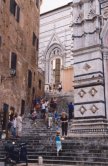 I really had no interest in the lecture, and decided that I would spend the day in Siena,
rather than waste the opportunity by seeing a lecture on something I had no real interest
in. We spent about 30-40 minutes trying to find a bathroom. No one seemed to have any
idea where they were going and we walked around in circles for a while. I gave up and
headed off on my own. Siena is a really cool city. At least the old section. It is
full of narrow, cobbled streets, alleys, and interesting shops. I found a place for lunch
and later ran into the rest of our little group at a cool church, which dominates the
skyline (see above left and right).
I really had no interest in the lecture, and decided that I would spend the day in Siena,
rather than waste the opportunity by seeing a lecture on something I had no real interest
in. We spent about 30-40 minutes trying to find a bathroom. No one seemed to have any
idea where they were going and we walked around in circles for a while. I gave up and
headed off on my own. Siena is a really cool city. At least the old section. It is
full of narrow, cobbled streets, alleys, and interesting shops. I found a place for lunch
and later ran into the rest of our little group at a cool church, which dominates the
skyline (see above left and right).
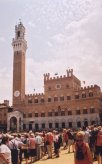 I managed to convince my roommates to skip the lecture and we headed over to the Bell Tower
and main square. Every year they run a horse race in the main square, which pits the
various neighborhoods against each other. The race is a no-holds-barred affair, with few
rules, other than that the first horse (with or without jockey) across the finish line wins.
The winning team gets to fly their banners around the city for the next year. Fortunately,
the race was not until the following week, so we were not completely inundated with crowds.
I managed to convince my roommates to skip the lecture and we headed over to the Bell Tower
and main square. Every year they run a horse race in the main square, which pits the
various neighborhoods against each other. The race is a no-holds-barred affair, with few
rules, other than that the first horse (with or without jockey) across the finish line wins.
The winning team gets to fly their banners around the city for the next year. Fortunately,
the race was not until the following week, so we were not completely inundated with crowds.
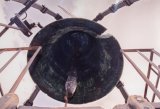 I am not a big fan of heights. However, I feel it is to my benefit to climb or ascend any
tall buildngs I can, as a therapy of sorts. So I got tickets and climbed the Bell Tower.
The climb inside was no problem, but when I got to the part where it opens up (see picture
above left, halfway up the white section), it was really scary. I had to force myself
to continue going. Then, when I got to the top, there was another short ladder that went to
a 6' X 6' wooden platform with no sides or roof, only a large bell (see right) above you. I
forced myself to go up there, and the views were fabulous. As was the pace of my heart.
I am not a big fan of heights. However, I feel it is to my benefit to climb or ascend any
tall buildngs I can, as a therapy of sorts. So I got tickets and climbed the Bell Tower.
The climb inside was no problem, but when I got to the part where it opens up (see picture
above left, halfway up the white section), it was really scary. I had to force myself
to continue going. Then, when I got to the top, there was another short ladder that went to
a 6' X 6' wooden platform with no sides or roof, only a large bell (see right) above you. I
forced myself to go up there, and the views were fabulous. As was the pace of my heart.
I descended and met my roommates in the square. Just then, the bell rang, announcing that
it was 1:00. If it had rung while I was up there, I probably would have died. I wrote out
some postcards and then we wandered around some shops before meeting up with our fellow
Florence travelers. We got our luggage from the bus and caught a bus up to Florence. With
a bit of difficulty, we found our hotel. The street kept changing names and the numbers
were in an odd sort of "order."
June 29, 2002 - Florence
 We had decided to go to some museums during the day. Florence is well known for its
fantastic art. Of course, we had not counted on there being -- prepare yourself -- a
museum-worker's strike. That is right. The entirely useless people sitting on stools in
air-conditioned comfort, surrounded by priceless works of art, decided to go on strike,
rather than sit around not helping people. So all of the museums, except the Duomo Museum,
were closed on Saturday. So in Venice the water buses were on strike, in Florence, the
museum workers. Doomed I tell you.
We had decided to go to some museums during the day. Florence is well known for its
fantastic art. Of course, we had not counted on there being -- prepare yourself -- a
museum-worker's strike. That is right. The entirely useless people sitting on stools in
air-conditioned comfort, surrounded by priceless works of art, decided to go on strike,
rather than sit around not helping people. So all of the museums, except the Duomo Museum,
were closed on Saturday. So in Venice the water buses were on strike, in Florence, the
museum workers. Doomed I tell you.
 We headed over to the Duomo, and saw the Ghiberti doors on the Baptistry, which are quite
cool. We then climbed the Duomo Tower (see right). This is quite tall and required a couple
of rest stops. Of course it affords an excellent view of the city. We headed back down and
then walked over to the Duomo Mueseum, which is government run and thus was open despite the
strike.
We headed over to the Duomo, and saw the Ghiberti doors on the Baptistry, which are quite
cool. We then climbed the Duomo Tower (see right). This is quite tall and required a couple
of rest stops. Of course it affords an excellent view of the city. We headed back down and
then walked over to the Duomo Mueseum, which is government run and thus was open despite the
strike.
 The Duomo Museum had a number of interesting works of art, and was arranged in an
interesting manner, with lots of open spaces and good light. Among other things, the
Duomo Museum had the original Ghiberti Doors. There are two sets of doors, the rather
plain ones (see left) and then the high-relief doors (see below right) that are also in the
Duomo Museum. The second set are much more detailed and seem to have a far more optimistic
look to them.
The Duomo Museum had a number of interesting works of art, and was arranged in an
interesting manner, with lots of open spaces and good light. Among other things, the
Duomo Museum had the original Ghiberti Doors. There are two sets of doors, the rather
plain ones (see left) and then the high-relief doors (see below right) that are also in the
Duomo Museum. The second set are much more detailed and seem to have a far more optimistic
look to them.
 We left the Duomo Museum and wandered about the city for a while. Florence is full of cool
Piazzas and a famous bridge, which we did not go to. We did head over to the Piazza della
Signoria, which is home to a remarkable collection of statues (see below), including a copy
of Michelangelo's David. The square is a huge tourist trap, full of overpriced cafes
and shops full of junk. You can also get your picture taken with 14th Century courtiers for
a couple of Euro. We skipped the honor, but I did pick up a few postcards. I also saw a
poster of Van Gogh's Starry Night, which cost € 1.50, and noted that it was not
authentic. Bummer. I thought for a moment that I could pick up an original Van Gogh for a
pittance, but it was not to be.
We left the Duomo Museum and wandered about the city for a while. Florence is full of cool
Piazzas and a famous bridge, which we did not go to. We did head over to the Piazza della
Signoria, which is home to a remarkable collection of statues (see below), including a copy
of Michelangelo's David. The square is a huge tourist trap, full of overpriced cafes
and shops full of junk. You can also get your picture taken with 14th Century courtiers for
a couple of Euro. We skipped the honor, but I did pick up a few postcards. I also saw a
poster of Van Gogh's Starry Night, which cost € 1.50, and noted that it was not
authentic. Bummer. I thought for a moment that I could pick up an original Van Gogh for a
pittance, but it was not to be.
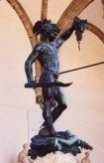
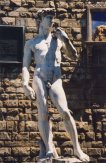
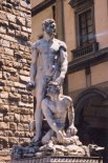
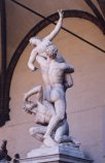
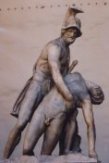
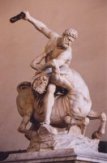
We headed back to the hotel and then walked over to the leather market, which was only
a couple of blocks from the hotel. I did not particularly need anything, but a couple of
the people were interested in getting leather jackets. We did a bit of shopping and a bit
of haggling, and I helped one of the girls get an extra 30% off an item she wished to buy.
June 30, 2002 - Florence and Pisa
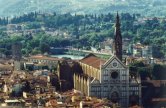 I got up early and headed over to the Academy Museum, home of Michelangelo's David.
I arrived at 7:30 a.m., and was the first person in line. The doors did not open until
8:20, but I wanted to make sure I was able to get in early before the crowds. You can call
up and get reservations and cut to the head of the line. However, this would require calling
someone who probably spoke limited English and I didn't have a phone card. After a little
while a few more people showed up, including a few with reservations.
I got up early and headed over to the Academy Museum, home of Michelangelo's David.
I arrived at 7:30 a.m., and was the first person in line. The doors did not open until
8:20, but I wanted to make sure I was able to get in early before the crowds. You can call
up and get reservations and cut to the head of the line. However, this would require calling
someone who probably spoke limited English and I didn't have a phone card. After a little
while a few more people showed up, including a few with reservations.
 At 8:20 I had my money out, exact change, and as soon as they let the people with reservations
in, I went to the ticket counter, got my ticket and headed right for David. I was
the only one in the room, except for a guard off to one side, for several minutes. It was
really incredible. David was the first sculpture by Michelangelo, and was carved
out of a discarded piece of marble that was flawed. It is difficult to describe what it is
about the statue that evokes such powerful feelings, but it is truly a masterpiece. The
dimensions are such that despite the statue's size, it appears to be properly proportioned
when you look up at it. Of special note are the hands, which are much larger and stronger
than normal. This was done to give the viewer an idea of how David was able to defeat the
much larger Goliath.
At 8:20 I had my money out, exact change, and as soon as they let the people with reservations
in, I went to the ticket counter, got my ticket and headed right for David. I was
the only one in the room, except for a guard off to one side, for several minutes. It was
really incredible. David was the first sculpture by Michelangelo, and was carved
out of a discarded piece of marble that was flawed. It is difficult to describe what it is
about the statue that evokes such powerful feelings, but it is truly a masterpiece. The
dimensions are such that despite the statue's size, it appears to be properly proportioned
when you look up at it. Of special note are the hands, which are much larger and stronger
than normal. This was done to give the viewer an idea of how David was able to defeat the
much larger Goliath.
 David is also interesting because the figure is at rest. Prior to this statue,
David was always seen in motion. There were several other pieces by Michelangelo in the
Acedemy, and I breezed through the museum unhindered by crowds, who were now heading to see
David. I saw the entire place in about 30 minutes. I then headed over to the
Uffizi. Unfortunately, by the time I arrived the museum had been open for some time and I
had to wait in line for almost an hour.
David is also interesting because the figure is at rest. Prior to this statue,
David was always seen in motion. There were several other pieces by Michelangelo in the
Acedemy, and I breezed through the museum unhindered by crowds, who were now heading to see
David. I saw the entire place in about 30 minutes. I then headed over to the
Uffizi. Unfortunately, by the time I arrived the museum had been open for some time and I
had to wait in line for almost an hour.
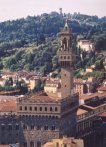 I zoomed around the Uffizi, popping in and out of the numerous rooms as quickly as possible.
I had to catch a train at 1:00 to Pisa, and still needed to go back to the hotel to pick up
my stuff and then find the train station. There were a number of famous works in the Uffizi,
of particular note was Botticelli's Birth of Venus, which was very large, covering
an entire wall of one room. After seeing the Birth of Venus, I headed out and back
to the hotel. I grabbed my stuff and headed off to the train station. Finding my way in
and to the proper track was something of an adventure in-and-of itself, but I made it on
time and caught my train.
I zoomed around the Uffizi, popping in and out of the numerous rooms as quickly as possible.
I had to catch a train at 1:00 to Pisa, and still needed to go back to the hotel to pick up
my stuff and then find the train station. There were a number of famous works in the Uffizi,
of particular note was Botticelli's Birth of Venus, which was very large, covering
an entire wall of one room. After seeing the Birth of Venus, I headed out and back
to the hotel. I grabbed my stuff and headed off to the train station. Finding my way in
and to the proper track was something of an adventure in-and-of itself, but I made it on
time and caught my train.
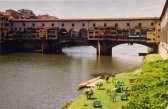 Perhaps this would be the appropriate time to tell of my adventures in getting a ticket to
climb the Leaning Tower of Pisa. When I arrived in Rome, a month earlier, I had made a
number of attempts to get tickets to climb the tower. I had seen an article stating that
it was open to tourists again after several years of shoring up the base and keeping it from
falling over. I also knew that reservations were necessary and only a couple of hundred
people were allowed up each day.
Perhaps this would be the appropriate time to tell of my adventures in getting a ticket to
climb the Leaning Tower of Pisa. When I arrived in Rome, a month earlier, I had made a
number of attempts to get tickets to climb the tower. I had seen an article stating that
it was open to tourists again after several years of shoring up the base and keeping it from
falling over. I also knew that reservations were necessary and only a couple of hundred
people were allowed up each day.
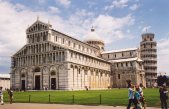 So I called the reservation number listed on the web, but they only spoke Italian. So I
had one of the teachers call for me. However, the woman said that you could only make
reservations over the web. I had already been to the website, which was not to start taking reservations until July 1, 2002 . . .
the day I intended to go.
So I called the reservation number listed on the web, but they only spoke Italian. So I
had one of the teachers call for me. However, the woman said that you could only make
reservations over the web. I had already been to the website, which was not to start taking reservations until July 1, 2002 . . .
the day I intended to go.
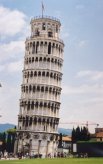 Fortunately, with the museums closed on Saturday, my roommate decided to go to Pisa on
Saturday and spend Sunday in Florence going to the museums. He got me a ticket to climb
the Leaning Tower, but I had to be there by 3:00. I arrived with time to spare, and found
out that if I had not gotten a ticket in advance, I would not have been able to climb it
until 6:00, which would have resulted in a lot of time sitting around with nothing to do,
and a later train back to Rome.
Fortunately, with the museums closed on Saturday, my roommate decided to go to Pisa on
Saturday and spend Sunday in Florence going to the museums. He got me a ticket to climb
the Leaning Tower, but I had to be there by 3:00. I arrived with time to spare, and found
out that if I had not gotten a ticket in advance, I would not have been able to climb it
until 6:00, which would have resulted in a lot of time sitting around with nothing to do,
and a later train back to Rome.
 Walking up the tower was really strange. The steps were old and extremely worn, but was
really weird was that because the staircase is circular, and the tower leans, at some points
you are climbing up the tower, and yet the staircase is nearly flat, and you are gaining
very little actual elevation. Once we got to the top we walked around, taking in the views.
There were about 15-20 people allowed up the tower at a time.
Walking up the tower was really strange. The steps were old and extremely worn, but was
really weird was that because the staircase is circular, and the tower leans, at some points
you are climbing up the tower, and yet the staircase is nearly flat, and you are gaining
very little actual elevation. Once we got to the top we walked around, taking in the views.
There were about 15-20 people allowed up the tower at a time.
 The top does not lean quite as much as other parts of the tower, because the tower is
somewhat banana shaped. The building started to lean early in the construction, and the
architect added weight to the other side in an attempt to straighten it out. However, this
only exacerbated the problem, as the tower was leaning because it was on unstable ground.
More weight just made it sink more. Eventually, they built the tower at an angle so that
it would appear more straight.
The top does not lean quite as much as other parts of the tower, because the tower is
somewhat banana shaped. The building started to lean early in the construction, and the
architect added weight to the other side in an attempt to straighten it out. However, this
only exacerbated the problem, as the tower was leaning because it was on unstable ground.
More weight just made it sink more. Eventually, they built the tower at an angle so that
it would appear more straight.
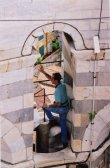 There are bells on each side of the tower, and they are interesting because the bells are
level with the ground and not with the floor of the tower (see above left). In addition to
the top floor, you can walk up a narrow stair inside the top wall that then turns into a
small spiral staircase (see right). This leads you up to the rim of the top wall. Of course
I had to climb to the very top. Depending on which side of the tower you are on, you either
seem to be hanging over nothing, or looking straight down at the side of the tower.
There are bells on each side of the tower, and they are interesting because the bells are
level with the ground and not with the floor of the tower (see above left). In addition to
the top floor, you can walk up a narrow stair inside the top wall that then turns into a
small spiral staircase (see right). This leads you up to the rim of the top wall. Of course
I had to climb to the very top. Depending on which side of the tower you are on, you either
seem to be hanging over nothing, or looking straight down at the side of the tower.
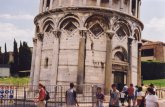 We climbed back down and I retrieved my stuff from the baggage locker. In addition to the
Leaning Tower, there is also a Duomo (seen above in the first Pisa picture). The Duomo
was damaged in an earthquake, and you can see the repairs that were done to the dome. I did
not bother going into the Duomo, and there is not much else of great interest in Pisa. So I
went back to the bus stop and caught a bus to the train station and a train back to Rome.
There were a couple of women with small children at the bus stop and apparently they were
pickpockets. A couple of the other tourists had almost been robbed. The kids carried
small pieces of cardboard that they would bump you with while they grabbed your valuables.
We climbed back down and I retrieved my stuff from the baggage locker. In addition to the
Leaning Tower, there is also a Duomo (seen above in the first Pisa picture). The Duomo
was damaged in an earthquake, and you can see the repairs that were done to the dome. I did
not bother going into the Duomo, and there is not much else of great interest in Pisa. So I
went back to the bus stop and caught a bus to the train station and a train back to Rome.
There were a couple of women with small children at the bus stop and apparently they were
pickpockets. A couple of the other tourists had almost been robbed. The kids carried
small pieces of cardboard that they would bump you with while they grabbed your valuables.
| Home | Rome Journal Home |
© 2005 John Eisinger. All rights reserved
Please report any problems to me.
 We had a group trip to Siena to walk around the old town and see a lecture on something. A
few of us had decided to go directly from Siena to Florence for the weekend, rather than
heading back to Rome. This would save us train-fare to Florence, and also get us there
earlier. We met early for the bus ride up to Florence, which took a while. We arrived
in Florence and were given directions as to where and when we were to meet for the lecture.
We had a group trip to Siena to walk around the old town and see a lecture on something. A
few of us had decided to go directly from Siena to Florence for the weekend, rather than
heading back to Rome. This would save us train-fare to Florence, and also get us there
earlier. We met early for the bus ride up to Florence, which took a while. We arrived
in Florence and were given directions as to where and when we were to meet for the lecture.






















